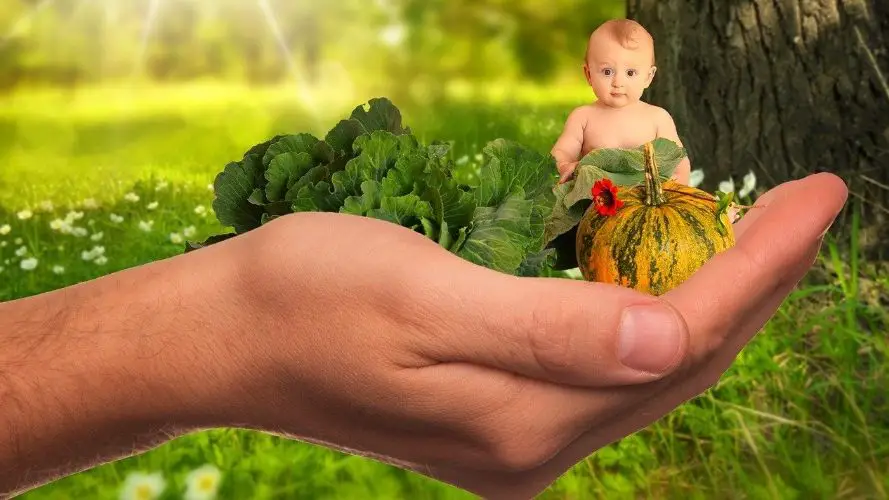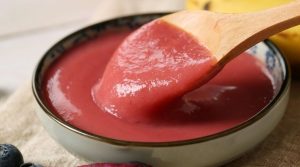Vegetables are a significant source of important nutrients, antioxidants, and dietary fiber in the human diet, beginning as soon as solid foods are introduced. Introducing vegetables to your baby while they’re young is good for their dietary health, and it also helps them to acclimate to the taste of veggies..
At six months, which is the approximate age at which solids should be introduced, your baby’s palate is a clean slate. Introducing a variety of freshly-cooked vegetables now is ideal; it helps to prepare them for the true taste and texture of vegetables in a way that purees generally do not, and to develop favorite vegetables and positive associations with plant-based foods.
We’ve assembled a guide to the best vegetables for babies by stage, including proper preparation and what produce should be avoided in a baby-safe diet.
Ready to dig in?
Best vegetables for six-month-olds
At six months, your little one is ready to try solid foods as a supplement to their diet of breast milk or formula. Because their ability to chew and swallow is still developing, they’ll need to stick to vegetables which can be steamed or roasted and mashed into a puree.
Avoid the temptation to salt or season vegetables now, allowing your child to taste the true flavor of the produce. The AAP suggests that home-prepared foods without sugar and salt additives ‘set the stage for lifelong healthy eating’, in contrast with some prepared baby and toddler foods high in sugar and sodium.1Baker, S. S., & Baker, R. D. (2015). Early exposure to dietary sugar and salt. Pediatrics, 135(3), 550-551.
pediatrics.aappublications.org
Avocados
- Key nutrients: Vitamins A, D, E, K, fiber, folate
- How to serve: Remove skin and pit from flesh; serve 1 tbsp, mashed
High in healthy monounsaturated fats that are key to the development of your child’s nervous system and brain, avocado is an easy choice because no cooking is required. Keep in mind that only small portions of the puree should be served.
Carrots
- Key nutrients: Beta carotene (Vitamin A), fiber
- How to serve: Steam or roast and puree
The natural sweetness of carrots makes them a frequent favorite of babies, who may find the orange vegetables preferable to more “green”-tasting (and looking) alternatives. Their fibrous makeup helps keep digestion smooth, and beta carotene is associated with both eye and immune health.
Peas
- Key nutrients: Protein
- How to serve: Steam and puree (liquid can be added to reduce thickness)
High in protein, peas are a great alternative to meat purees for parents hoping to keep diets plant-based. Steaming and mashing them from frozen is quite simple, but you may need to add a bit of liquid (breast milk, formula, or water) to thin the mixture to a safe consistency.
Pumpkin
- Key nutrients: Vitamins A and C
- How to serve: Serve from canned, or roast/steam and puree fresh pumpkin flesh (outer rind, seeds, and strings removed)
This fall favorite is high in both vitamin A and vitamin C, and has a natural sweetness and baby-friendly texture which make it a popular puree. You can roast or steam a fresh pumpkin, but canned is fine and far less work (just make sure it’s pumpkin only, and not pumpkin pie mix).
Sweet potato
- Key nutrients: Vitamins A, B6, and C, fiber, manganese
- How to serve: Roast or steam, remove skin, mash well
As their name suggests, sweet potatoes share the naturally pleasant taste of the other orange vegetables on our list, making them an easy sell to babies. Be sure to fully remove the skin, mash the flesh, and let it cool a bit before feeding to your baby — these dense roots can stay surprisingly hot after cooking, especially if the skin is left on.
Spinach
- Key nutrients: Iron
- How to serve: Steam and puree from fresh or frozen
Iron is an important nutrient in child development, helping to give kids energy. Spinach, which is a high-iron vegetable, is also easy to puree and serve; the only downside is that many kids find the taste unappealing, and it’s one of few situations where we’d recommend adding a tiny pinch of salt to help things along.
Best vegetables for nine-month-olds
As your baby’s ability to grasp foods, self-feed, chew, and swallow improves, their culinary world expands significantly — that includes these vegetables:
Beets
- Key nutrients: Fiber, folate, manganese
- How to serve: Pureed
Though they may be a challenging taste for tots to enjoy, beets are packed with nutrition and do have a natural sweetness that some kids find appealing. Pureeing beets with another sweet vegetable or fruit can help to cut the taste and keep the nutrition.
Broccoli
- Key nutrients: Vitamins C and K1, folate, iron, manganese, potassium
- How to serve: Steam or roast until very soft
One of the world’s most popular vegetables, this nutty crucifer is highly nutritious and has a flavor that’s naturally elevated by roasting. It can also be steamed, pureed, or added to soft casseroles.
Cauliflower
- Key nutrients: Vitamins C and B-6, magnesium
- How to serve: Steam or roast and roughly smash
Offering a surprising megadose of Vitamin C, the neutral and nutty taste of cauliflower tends to be easy for babies to tolerate. The texture of a rough, roasted cauliflower mash also encourages more chewing than purees, important at this transitional age.
Onions
- Key nutrients: Vitamins B-6 and C, potassium
- How to serve: Cooked with other vegetables, in complete dishes
If you love to cook with aromatics like onion, you’re likely eager to make sure your child isn’t one of the notorious “haters” of the C-rich vegetable by acclimating them early. Try roasting or steaming it with other vegetables you’re serving to your child, or putting them into a casserole or stew.
Tomatoes
- Key nutrients: Vitamins A and C
- How to serve: Slice into bite-sized pieces
Hydrating and rich in healthy vitamins, tomatoes are a staple food throughout most of the world. Whether you grow them or buy them, serving up simple toddler-safe slices makes an easy snack or side.
Zucchini
- Key nutrients: Vitamin A, manganese, potassium
- How to serve: Roasted, steamed, spiralized and sauteed
Cheap during the summer months, yellow and green squash make for a nutritious, baby-friendly meal that’s lightly sweet and plays well with other flavors. When spiralized, it can be served just like spaghetti.
Vegetables and baby-led weaning
Baby-led weaning refers to the process of allowing your child to engage in self-directed feeding while weaning by offering a variety of nutritious foods that can be self-fed. Vegetables are an ideal addition to BLW, and these four are among the easiest to incorporate.
Bell peppers
- Key nutrients: Vitamin C
- How to serve: Cut into long, thin strips
Easy to serve and boasting more vitamin C than an orange, bell peppers make a tasty, crunchy snack that’s easy for toddler hands to grasp. The taste may be sharp to some, though — try a yogurt-based dip or hummus accompaniment.
Butternut squash
- Key nutrients: Vitamin C, fiber, magnesium, potassium
- How to serve: Cube and roast or steam
Lightly sweet and easy to chew, nutritious butternut squash has been a popular vegetable in baby foods for many years. They’re also inexpensive in fall and can keep in their whole form for months, but can be difficult to cut and peel.
Cucumbers
- Key nutrients: Vitamins C and K
- How to serve: Peel and slice into spears
Cool, hydrating, and naturally high in vitamin K, which boosts blood health, cucumbers make a great summer snack that doubles as a soother for teething babies. Long, thin spears let them safely grasp the vegetable, which should be peeled to avoid choking.
Edamame
- Key nutrients: Protein
- How to serve: Steamed, removed from shell, lightly mashed
These nutty little soybeans are easy to prepare, but they need to be lightly mashed in order to be baby-safe — otherwise, they can present a choking hazard.
Vegetables that aren’t safe for baby
While many vegetables are safe for babies and toddlers when prepared properly, there are some vegetables and preparations you should avoid.
- Baby-cut carrots: Though these carrots are small and have a similar size and shape to other veggies used in baby-led weaning, they’re too hard for your little one to chew properly and can be a choking hazard.
- Corn kernels: While creamed corn and corn puree are okay, individual corn kernels can become lodged in the airway and create a choking hazard.
- Raw celery: The stringy, fibrous consistency of a celery stick can pose a choking hazard, so only serve celery when cooked and cut into bite sized pieces.
Any hard vegetable: Per the AAP, raw vegetables can be a choking hazard until kids are over four.2Choking Prevention
pediatrics.aappublications.org
How to identify and cope with a vegetable allergy
Vegetable allergies are less common than wheat, dairy, egg, and other top-8 allergens, but that doesn’t mean an allergic reaction is impossible. As always, when you introduce a new food to your child, monitor them after eating to ensure that their body is processing the food normally.
If your child experiences digestive symptoms, rashes, hives, or wheezing after trying a new vegetable or consistently after eating a vegetable, it’s possible that they have an allergy or intolerance. Talk to your pediatrician for more information.
Our takeaways
As an important part of a healthy diet, it’s wise to introduce babies to vegetables as soon as they begin consuming solid food. Simple purees like carrots, peas, sweet potato, and avocado can be made and served without trouble.
When your baby is more capable of chewing and swallowing, more complex mashes and soft vegetables like broccoli, cauliflower, and squash can be introduced. Finally, when engaging in baby-led weaning, offering a variety of graspable foods for self-directed feeding can encourage children to develop the habit of eating vegetables.
Early introduction to vegetables can be significant in helping to establish a lifelong pattern of healthy eating, but it’s important that salt and sugar be avoided when cooking for young children; avoiding these additives and using fresh foods rather than premade purees helps to keep baby and toddler diets healthy and allows children to adapt to the true taste of vegetables.








